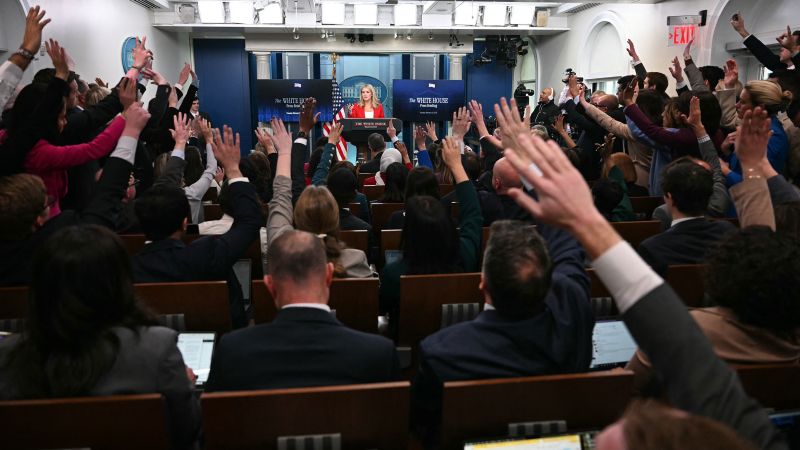CNN
—
In the Trump administration’s latest assertion of power over the press corps, the White House intends to take over the seating assignments in the press briefing room, according to a senior official.
The plan may cause a tug-of-war with the White House Correspondents’ Association, the independent group that currently assigns seats and manages the relationship between the White House and the press corps.
When Axios reported on the potential seating chart changes on Sunday morning, some Trump allies cheered the news as yet another way to constrict the mainstream media establishment and elevate explicitly pro-Trump opinion outlets.
“Yes to this – keep it going @PressSec,” the first press secretary from Trump’s first term, Sean Spicer, wrote on X to his counterpart Karoline Leavitt.
A senior White House official confirmed the plan to CNN but did not add any details.
Several correspondents said a shakeup to the seating chart has been expected since the changes would be full of symbolism and would be celebrated by pro-Trump media outlets. The sources spoke on condition of anonymity because they were not authorized by their employers to speak publicly.
“It doesn’t really matter where people sit,” a White House correspondent said. “But it does matter when the White House tries to impact what questions are asked, and how stories are covered, by taking control away from an elected group.”
That group is the correspondents’ association, which is governed by a rotating group of journalists who are elected by their peers.
The current president of the group, Eugene Daniels, did not respond to a request for comment about the status of the seating chart. The association is said to be considering a range of possible responses.
One big unknown is whether the administration intends to remove some big news outlets from assigned seats or merely rearrange who sits where.
Even a seemingly minor reordering, though, could change the dynamic during Leavitt’s briefings.
Right now, under the association’s seating chart, journalists from the country’s biggest TV networks, newswires, newspapers, and radio networks sit toward the front. A wide range of other well-established news outlets also have assigned seats, with some taking turns in order to fit more than 60 outlets into 49 seats.
Every few years the association updates the seating chart to reflect changes across the media landscape. It also assigns “all booths and desks” in the news media’s White House workspace, its website notes.
The Trump White House has been sharply critical of the association since Trump retook office in January. Some correspondents believe Trump wants to eliminate the group altogether.
In February Trump banned The Associated Press, a foundational part of White House coverage for more than one hundred years, from press conferences and other events. Then Leavitt said the White House would pick the “press pool” reporters who travel with the president and attend small-scale events with him, thereby stripping the association of its historic role organizing the pool.
In recent weeks, the White House has invited hyperpartisan pro-Trump websites and relatively low-rated TV networks into the pool. “I love this guy,” Trump gushed on Friday when an employee of the far-right channel One America News offered a compliment disguised as a question.
Leavitt has also promoted right-wing podcasters and heterodox writers at her press briefings by turning a seat formerly occupied by a White House aide into a “new media seat.”
Longtime correspondents have girded for further changes, especially in light of the Defense Department’s so-called “rotation” program, which removed big news outlets like NPR and CNN from their Pentagon workspaces and replaced them with smaller, ardently pro-Trump media outlets.
All of the disruptions have pointed in the same predictable direction: Toward media coverage that supports rather than scrutinizes the administration’s agenda.
A Trump-controlled seating chart at briefings would likely add right-wing podcasters and online content creators, though the White House may run into some practical constraints. Many of the pro-Trump personalities who command big online audiences with conservative opinion shows don’t live in Washington, DC, and have little desire to drop in for press briefings.
During the early days of the Covid-19 pandemic in 2020, when briefing room capacity was reduced for health reasons, CNN’s Kaitlan Collins was told to move out of her first-row seat and switch with a reporter in the back row. Both reporters refused, and the White House backed down.
The president of the association at the time, Jonathan Karl, said “there is a decades-long bipartisan tradition of the WHCA determining the seating assignments in the briefing room,” so “we will challenge any effort to pick and choose what outlets are there or the manner in which they are in there.”

